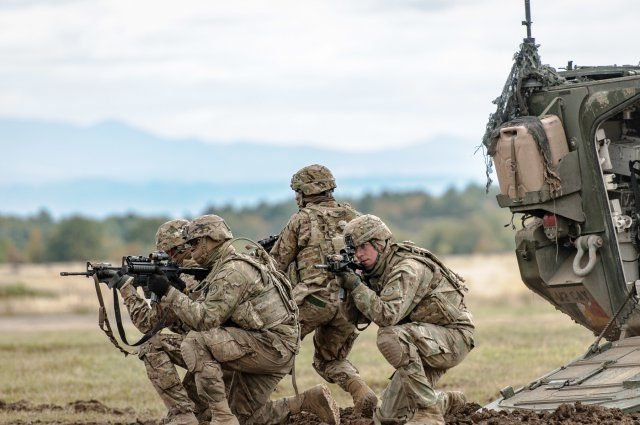
By U.S. Army Europe
As U.S. Secretary of Defense Ash Carter announced in Brussels last week, U.S. Army Europe is preparing for an increased presence across the European theater to contribute to and strengthen the alliance’s deterrence and defense. On Nov. 3, the U.S. Department of the Army announced the first rotational units to deploy in support of those efforts.
“Everything we’re about to do — everything we’ve been planning here at U.S. Army Europe for these rotational units — comes from the alliance’s decisions at the Wales and Warsaw summits,” said Lt. Gen. Ben Hodges, U.S. Army Europe commander. “These activities are the embodiment of the United States’ commitment to deterring aggression and defending our European allies and partners.”
The 3rd Armored Brigade Combat Team, 4th Infantry Division, from Fort Carson, Colorado, will arrive in Europe in January. Their arrival will mark the beginning of the heel-to-toe rotation of U.S.-based armored brigades to Europe; in other words, the continuous presence of an armored brigade combat team and back-to-back rotations of U.S. troops and equipment.
The full set of 3/4 ABCT equipment will arrive at the port in Bremerhaven, Germany, in January and then move by rail, commercial line haul and military convoy to Poland where the brigade will consolidate before distributing units across seven countries from Estonia to Bulgaria beginning in February. Over the course of their nine-month rotation, 3/4 ABCT will routinely move units across the region to participate in training events and exercises.
The armored brigade will initially consolidate in western Poland, centered on the training areas at Drawsko Pomorskie and Zagan. Following this initial consolidation, the brigade will establish itself at various operating locations through the region. The brigade headquarters; brigade engineering and support battalions; 3rd Battalion, 29th Field Artillery Regiment; and 4th Squadron, 10th Cavalry Regiment, will operate from existing Polish military installations in Zagan, Swietoszow, Skwierzyna, and Boleslawiec.
From the consolidation sites in Poland, 1st Battalion, 68th Armor Regiment, will move to the Baltic nations and remain positioned there until NATO’s Enhanced Forward Presence, or eFP, battle groups are in place and then will rotate throughout Europe to participate in exercises as requested. The 1st Battalion, 8th Infantry Regiment, will support Operation Atlantic Resolve activities primarily in Bulgaria and Romania. The 1st Battalion, 66th Armor Regiment, will move to the Grafenwöhr Training Area, Germany, where it will conduct training and maintenance to build and sustain readiness.
As part of the expansion of the rotational U.S. presence, the Army will continue to invest in the training and mission command capabilities at Novo Selo Training Area, Bulgaria, and Mihail Kogalniceanu Air Base, Romania, to support a persistent and continuous armored presence in the Black Sea region.
In addition to the rotational armored brigade, the Army will provide a rotational combat aviation brigade to the European theater to support Operation Atlantic Resolve and other joint and multinational efforts. By the end of March, the 10th Combat Aviation Brigade from Fort Drum, New York, will arrive in Europe for a nine-month rotation. The brigade will be headquartered in Illesheim, Germany, and will forward deploy aircraft in Latvia, Romania, and Poland to enhance the alliance’s ability to deter aggression.
Armored and aviation brigade rotations are scheduled into the foreseeable future, though specific units have not yet been identified. Their presence enhances the deterrence capabilities available to the U.S. Army Europe and U.S. European Command commanders to respond to potential crises and assist in the defense of our allies and partners in the European community.
To oversee these rotational forces, the 4th Infantry Division headquarters, which has been the regionally aligned division headquarters for Europe since 2015, will continue to be the tactical headquarters for all U.S. land forces conducting activities in support of Operation Atlantic Resolve. Based in Baumholder, Germany, the 4th ID Mission Command Element is the forward deployed headquarters element that provides U.S. Army Europe a division-level command and control capability.
“The 4th Infantry Division Mission Command Element is integral to Army Europe’s ability to conduct Operation Atlantic Resolve missions,” Hodges said. “They’re a small element — less than 100 Soldiers — but they make a huge impact in the theater by controlling so many moving parts.”
It is important to note the expansion of rotational forces is separate and distinct from NATO’s eFP battle groups. Both will contribute to the alliance’s deterrence and defense capabilities, but the rotational armored and aviation forces will remain under U.S. command. The rotational forces will focus on strengthening capabilities and sustaining readiness through bilateral and multinational training and exercises. The United States, as the framework nation for the Poland-based NATO eFP unit, will deploy 2nd Squadron, 2nd Stryker Cavalry Regiment (2/2 CR), based in Vilseck, Germany, to Orzysz, Poland, in April 2017.
Starting in September 2016, the Army began assembling additional Army Prepositioned Stocks for storage in Europe. The additional APS set will consist of equipment and ammunition required to support armored division-sized force. These capabilities reduce deployment timelines, improve our deterrence capabilities and provide additional combat power to U.S. European Command for use in contingency operations. The equipment can also be drawn for use in training and exercises.
While some of this APS equipment was previously used by rotating brigade combat teams in Europe, the majority of additional APS equipment is being sourced from across the Army. Equipment will be stored at facilities in Eygelshoven, Netherlands; Zutendaal, Belgium; and Miesau and Dülmen, Germany.
